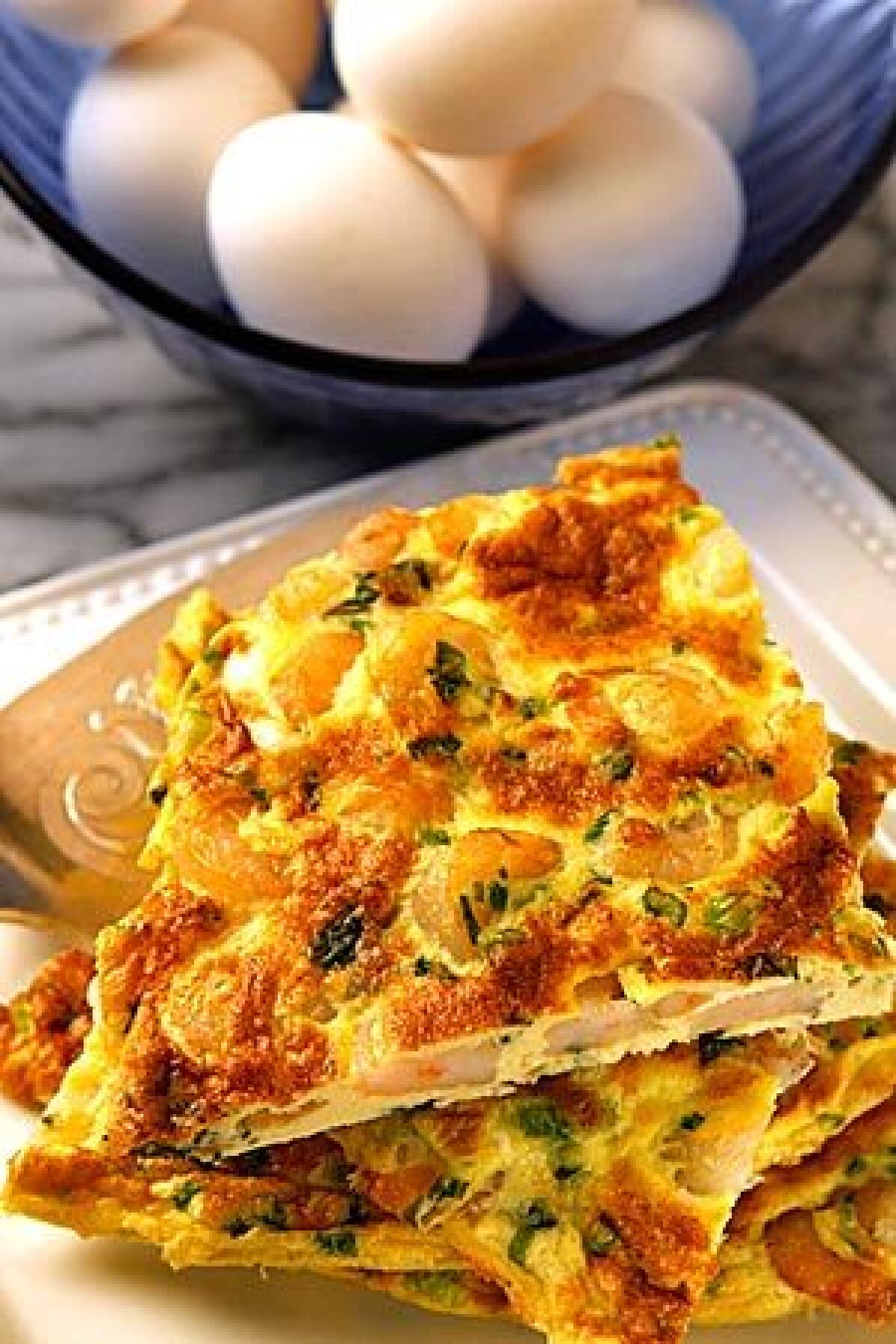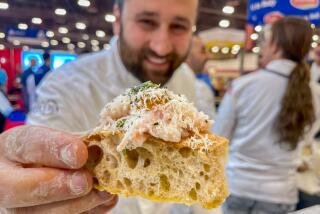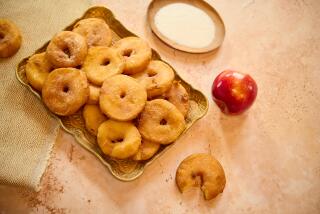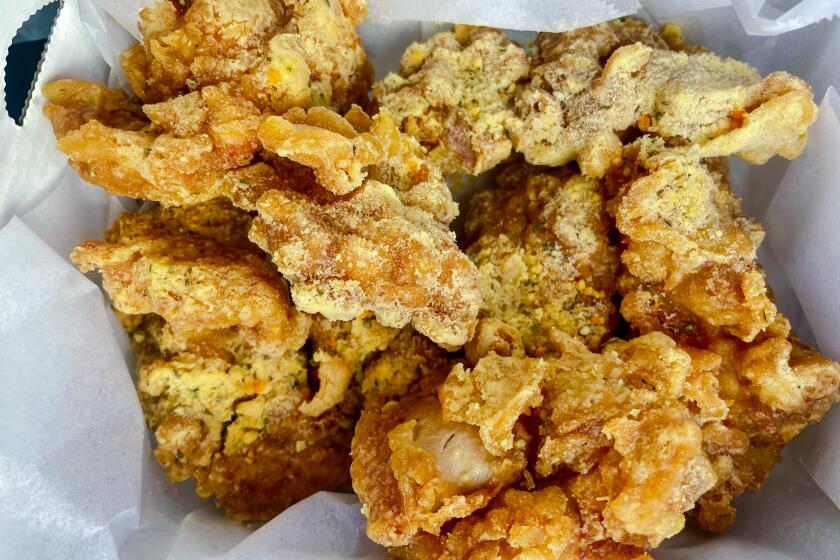The California Cook: Fuss-free frittatas

Dinners at this time of year make me cranky — most of time when I get home from work the house is too hot to cook, and besides that, I usually have neither the patience nor the energy to fix much of anything. But tonight I’m not worried. I’ve got two frittatas waiting in the refrigerator.
We just about live on them. Cut a couple of slices and bring in some tomatoes from the garden and that’s dinner. Add a couple glasses of rosé and that’s a feast.
FOR THE RECORD:
Frittata recipe: In the Sept. 9 Food section, a recipe for prosciutto and onion frittata called for 2 tablespoons of grated Parmigiano- Reggiano but did not explain how they were to be used. They should be sprinkled over the frittata before broiling. The corrected recipe can be found online at latimes.com/prosciutto- frittata. —
The odd thing is that frittatas aren’t more popular. Or maybe that’s not so strange after all. The standard definition is “a flat omelet,” which, I suppose, is accurate, as far as it goes — both are made from eggs, which form a base for delivering ingredients as diverse as cheese and spinach.
But once you get beyond the obvious the two couldn’t be more different, and the frittata suffers in the comparison. An omelet is a thing of fragile beauty, depending on quick, careful cooking and immediate eating. It can take years to master making them, and to be appreciated at its best, an omelet must be consumed within minutes.
The frittata is a much friendlier beast, more accommodating in both preparation and service. While you wouldn’t wish leftover omelet on anyone, frittatas are as good at room temperature the next day as they are piping hot out of the oven. Best of all, they couldn’t be easier to make — as long as you’re willing to disregard the standard instructions.
Read most cookbooks, in either English or Italian, and they’ll tell you to fix a frittata pretty much the same way you’d fix an omelet, stirring and scrambling and lifting the cooked egg to let the raw slide through. Then when the eggs have just firmed, turn them over to cook the other side, either with a flip and a flick of the wrist, or by inverting them onto a plate or a lid and sliding them back into the pan.
The first requires a certain gymnastic ability and a dead aim (or a dog that will clean up any eggy misses off the floor). The latter is just plain messy.
Still, this was the way I made frittatas for years. In the spring, I love a frittata made with slender asparagus. Leave them unpeeled and cook them just until they begin to wave before you add them to the egg mixture. Another favorite is made with squash blossoms — chop them roughly and cook them briefly with onions before stirring them into the eggs. The vivid orange is gorgeous against the pale yellow background.
But maybe my favorite frittata is one I make in the summer with zucchini. Coarsely grate about a pound of it (an old-fashioned box grater works fine). Then sauté the grated zucchini with some slow-cooked onions just until it softens and changes color. Stir this into a half-dozen eggs beaten with a half-cup of Parmigiano-Reggiano and eight to 10 torn basil leaves and cook.
It was this last frittata that led me to an easier way of cooking them. And talk about hiding in plain sight: It came from Marcella Hazan, the queen of Italian cooking. I could have sworn that in the last 25 years I had cooked almost every recipe in every one of her books. How had I missed this one?
In fact, I stumbled across it looking for the proportions for that zucchini omelet. It was one of those things: I thought I remembered the recipe being one of Hazan’s. Ironically, though she has a recipe for zucchini frittata, it’s not at all the one I was thinking of (she slices the zucchini rather than grating it, and uses a lot less).
But it was reading over the basic technique that turned my head around. Hazan’s way of cooking a frittata is utterly simple: rather than all of that stirring and scraping of the eggs as they cook, she simply leaves them to set over a very low heat. Then instead of flipping the frittata, she just runs it under a hot broiler to set and brown the top.
Not only is her way easier, but when I tried the same recipe using both techniques side by side, it made a frittata that was moister and more tender. The only refinements I’d add are that it cooks best if you cover the pan during the stovetop cooking to trap the heat, and that it unmolds easiest if you use a nonstick skillet.
The key to getting it exactly right is letting it cook slowly on top of the stove until there is just a shallow puddle of raw egg left on top, and then sticking it under the broiler for only a couple of minutes. If the top colors before it is firm, just remove it from the broiler, replace the lid and let it sit for a few minutes to finish cooking.
Probably the hardest part is unmolding the frittata from the pan; even in a nonstick, eggs will want to adhere. So use a small spatula to free the edges, then rap the pan hard a couple of times on the cutting board. It’ll bang really loud, but the bottom of the frittata should pop free. Then you just need to slide it onto a plate for serving.
Once you’ve grasped the basics, frittatas are really easy to improvise. For a 10-inch skillet, you’ll need about six eggs and 1 to 1½ cups of cooked filling. At least part of that should be cooked onion; a frittata lacks that certain savory quality without it. On the other hand, use garlic sparingly, if at all.
Cheese can be added at your whim. For most frittatas, I think Parmigiano is a perfect match with the flavor of egg. But I could certainly see using Pecorino in some situations. And in some cases (such as seafood frittatas), maybe you won’t want any cheese at all.
Probably the simplest frittata I made during this most recent spree is also one of the best. Sauté some chopped green onions in butter, add shelled shrimp and cook just until they are firm. Stir in the egg with some basil, pop it on the stove and there you are.
Another favorite is only a little more complicated. Based on Parsons’ First Law of Cooking (anything that combines long-cooked onions, ham and cheese is going to be good), I sautéed onions until they were sweet and soft, tossed in some slivered prosciutto and then beat the eggs with a good handful of grated Parmigiano.
Which one’s for dinner tonight? That’s a tough call — one’s flavor is simple and direct, the other is more complex and comforting. And the really great thing is, now that these frittatas are so easy to make, I no longer have to choose.
More to Read
Eat your way across L.A.
Get our weekly Tasting Notes newsletter for reviews, news and more.
You may occasionally receive promotional content from the Los Angeles Times.











